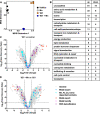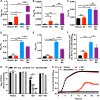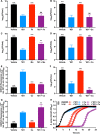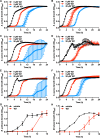A Small-Molecule Modulator of Metal Homeostasis in Gram-Positive Pathogens
- PMID: 33109764
- PMCID: PMC7593973
- DOI: 10.1128/mBio.02555-20
A Small-Molecule Modulator of Metal Homeostasis in Gram-Positive Pathogens
Abstract
Metals are essential nutrients that all living organisms acquire from their environment. While metals are necessary for life, excess metal uptake can be toxic; therefore, intracellular metal levels are tightly regulated in bacterial cells. Staphylococcus aureus, a Gram-positive bacterium, relies on metal uptake and metabolism to colonize vertebrates. Thus, we hypothesized that an expanded understanding of metal homeostasis in S. aureus will lead to the discovery of pathways that can be targeted with future antimicrobials. We sought to identify small molecules that inhibit S. aureus growth in a metal-dependent manner as a strategy to uncover pathways that maintain metal homeostasis. Here, we demonstrate that VU0026921 kills S. aureus through disruption of metal homeostasis. VU0026921 activity was characterized through cell culture assays, transcriptional sequencing, compound structure-activity relationship, reactive oxygen species (ROS) generation assays, metal binding assays, and metal level analyses. VU0026921 disrupts metal homeostasis in S. aureus, increasing intracellular accumulation of metals and leading to toxicity through mismetalation of enzymes, generation of reactive oxygen species, or disruption of other cellular processes. Antioxidants partially protect S. aureus from VU0026921 killing, emphasizing the role of reactive oxygen species in the mechanism of killing, but VU0026921 also kills S. aureus anaerobically, indicating that the observed toxicity is not solely oxygen dependent. VU0026921 disrupts metal homeostasis in multiple Gram-positive bacteria, leading to increased reactive oxygen species and cell death, demonstrating the broad applicability of these findings. Further, this study validates VU0026921 as a probe to further decipher mechanisms required to maintain metal homeostasis in Gram-positive bacteria.IMPORTANCEStaphylococcus aureus is a leading agent of antibiotic-resistant bacterial infections in the world. S. aureus tightly controls metal homeostasis during infection, and disruption of metal uptake systems impairs staphylococcal virulence. We identified small molecules that interfere with metal handling in S. aureus to develop chemical probes to investigate metallobiology in this organism. Compound VU0026921 was identified as a small molecule that kills S. aureus both aerobically and anaerobically. The activity of VU0026921 is modulated by metal supplementation, is enhanced by genetic inactivation of Mn homeostasis genes, and correlates with increased cellular reactive oxygen species. Treatment with VU0026921 causes accumulation of multiple metals within S. aureus cells and concomitant upregulation of genes involved in metal detoxification. This work defines a small-molecule probe for further defining the role of metal toxicity in S. aureus and validates future antibiotic development targeting metal toxicity pathways.
Keywords: MRSA; Staphylococcus aureus; antibiotics; cobalt; copper; manganese; metalloregulation.
Copyright © 2020 Juttukonda et al.
Figures








Similar articles
-
Manganese Detoxification by MntE Is Critical for Resistance to Oxidative Stress and Virulence of Staphylococcus aureus.mBio. 2019 Feb 26;10(1):e02915-18. doi: 10.1128/mBio.02915-18. mBio. 2019. PMID: 30808698 Free PMC article.
-
Staphylococcal Bacterial Persister Cells, Biofilms, and Intracellular Infection Are Disrupted by JD1, a Membrane-Damaging Small Molecule.mBio. 2021 Oct 26;12(5):e0180121. doi: 10.1128/mBio.01801-21. Epub 2021 Oct 12. mBio. 2021. PMID: 34634935 Free PMC article.
-
Genetic Regulation of Metal Ion Homeostasis in Staphylococcus aureus.Trends Microbiol. 2020 Oct;28(10):821-831. doi: 10.1016/j.tim.2020.04.004. Epub 2020 May 4. Trends Microbiol. 2020. PMID: 32381454 Free PMC article. Review.
-
Arachidonic Acid Kills Staphylococcus aureus through a Lipid Peroxidation Mechanism.mBio. 2019 Oct 1;10(5):e01333-19. doi: 10.1128/mBio.01333-19. mBio. 2019. PMID: 31575763 Free PMC article.
-
Metalloregulation of Gram-positive pathogen physiology.Curr Opin Microbiol. 2012 Apr;15(2):169-74. doi: 10.1016/j.mib.2011.11.008. Epub 2011 Dec 10. Curr Opin Microbiol. 2012. PMID: 22155062 Free PMC article. Review.
Cited by
-
Coordination Complexes to Combat Bacterial Infections: Recent Developments, Current Directions and Future Opportunities.Chemistry. 2021 May 6;27(26):7340-7350. doi: 10.1002/chem.202004822. Epub 2021 Feb 25. Chemistry. 2021. PMID: 33368662 Free PMC article. Review.
-
Syntheses and structures of dinuclear zinc(II) acetate-bridged coordination compounds with the aromatic Schiff base chelators N,N-dimethyl-2-[phen-yl(pyridin-2-yl)methyl-idene]hydrazine-1-carbothio-amide and N-ethyl-2-[phen-yl(pyridin-2-yl)methyl-idene]hydrazine-1-carbo-thio-amide.Acta Crystallogr E Crystallogr Commun. 2025 Jun 24;81(Pt 7):636-641. doi: 10.1107/S2056989025005407. eCollection 2025 Jul 1. Acta Crystallogr E Crystallogr Commun. 2025. PMID: 40630661 Free PMC article.
-
Controllable self-cleaning FET self-assembled RNA-cleaving DNAzyme based DNA nanotree for culture-free Staphylococcus aureus detection.J Nanobiotechnology. 2024 Jul 15;22(1):414. doi: 10.1186/s12951-024-02682-3. J Nanobiotechnology. 2024. PMID: 39010059 Free PMC article.
-
Antibacterial insights into alternariol and its derivative alternariol monomethyl ether produced by a marine fungus.Appl Environ Microbiol. 2024 Apr 17;90(4):e0005824. doi: 10.1128/aem.00058-24. Epub 2024 Mar 12. Appl Environ Microbiol. 2024. PMID: 38470179 Free PMC article.
-
Easy, Flexible and Standardizable Anti-Nascent Biofilm Activity Assay to Assess Implant Materials.Microorganisms. 2023 Apr 14;11(4):1023. doi: 10.3390/microorganisms11041023. Microorganisms. 2023. PMID: 37110446 Free PMC article.
References
-
- Silver LL, Bush K. 2016. Antibiotics and antibiotic resistance. Cold Spring Harbor Laboratory Press, Cold Spring Harbor, NY.
-
- CDC. 2019. Antibiotic resistance threats in the United States. CDC, Atlanta, GA. https://www.cdc.gov/DrugResistance/Biggest-Threats.html.
-
- WHO. 2017. Global priority list of antibiotic-resistant bacteria to guide research, discovery, and development of new antibiotics. WHO, Geneva, Switzerland. https://www.who.int/medicines/publications/WHO-PPL-Short_Summary_25Feb-E....
Publication types
MeSH terms
Substances
Grants and funding
LinkOut - more resources
Full Text Sources
Medical
Molecular Biology Databases
